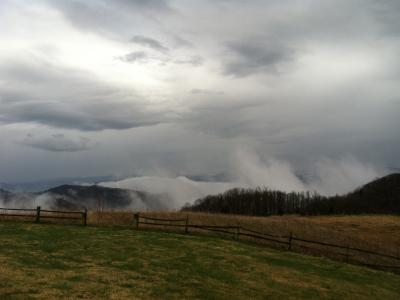
In mist-enshrouded cloud forests, the ecosystem can differ dramatically from those nearby. But exactly why hasn't been clear.
Now, some of the secrets of these foggy mountaintop stretches are being revealed. One surprise: On cloudy days, these misty forests may actually see more light than they would on a perfectly sunny day.
"Sometimes it's brighter than complete sunlight," Keith Reinhardt, a plant physiologist at Idaho State University, said last month at the annual meeting of the American Geophysical Union in San Francisco. That's because some of the filtered light scatters off the cloudsand is combined with direct sunlight before reaching the leaves.
The leaves must also deal with a wider range of light and water conditions than other mountain forests, the research found. [In Photos: Life Up in the Clouds]
Ethereal places
Anyone who has been on a mountain hike has seen how the misty mountaintop ecosystem can be a world away from one just a few hours' hike below.
To find out why, Reinhardt and his colleagues placed light, temperature and moisture sensors on spruce fir trees in the southern Appalachian forestsstretching from Virginia to the Great Smokey Mountains. The mountains, about 6,500 feet (2,000 meters) high, are cool and wet, with cloud bottoms often grazing the forest floor, and mountaintops shrouded in fog for 60 to 80 percent of all the days in the growing season, Reinhardt said.
Get the world’s most fascinating discoveries delivered straight to your inbox.
Unsurprisingly, on the few sunny days, the trees were exposed to bright light, and completely cloudy days were very, very dark.
But on partly cloudy days, the leaves see a huge range in light conditions, from very dark to blindingly bright. That's because light scattered from cloud edges combines with the direct sunlight, amplifying the light exposure. While an individual leaf may see less light, the forest on average, as an ecosystem, sees quite a bit, Reinhardt said.
Afternoon energy boost
In other forests, the process of making food from light, known as photosynthesis, tends to drop off in the afternoon. But these sky island trees see a boost in their energy harvesting into midday, perhaps to take advantage of a period when a diffuse light penetrates the formerly dark corners of the forest, the researchers said.
The team also measured how easily air bubbles form in the xylem, the water-transporting vascular system of trees. The more easily such "embolisms" form, the more sensitive trees are to drought.
Despite being enshrouded in mist all the time, the trees, which grow at higher, and potentially dryer, elevations, didn't form embolisms easily and so tended to be more drought-resistant than similar trees in other ecosystems.
"These trees might not be designed for when the clouds are there, but when the clouds are not there," Reinhardt said. "These are relatively high elevation sites, so when the clouds are not there, it can get pretty dry."
Follow Tia Ghose on Twitter and Google+. Follow us @livescience, Facebook & Google+. Original article on LiveScience.

Tia is the editor-in-chief (premium) and was formerly managing editor and senior writer for Live Science. Her work has appeared in Scientific American, Wired.com, Science News and other outlets. She holds a master's degree in bioengineering from the University of Washington, a graduate certificate in science writing from UC Santa Cruz and a bachelor's degree in mechanical engineering from the University of Texas at Austin. Tia was part of a team at the Milwaukee Journal Sentinel that published the Empty Cradles series on preterm births, which won multiple awards, including the 2012 Casey Medal for Meritorious Journalism.


